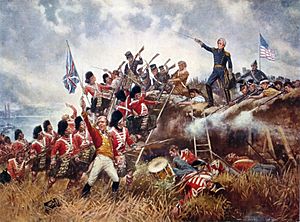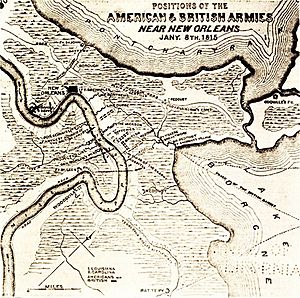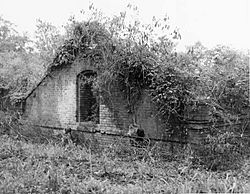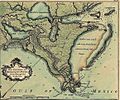Battle of New Orleans facts for kids
The Battle of New Orleans was the very last major battle of the War of 1812. It happened between the British and the Americans. The main fight took place on January 8, 1815. About 8,000 British soldiers fought. Their leader was General Edward Pakenham. The American forces were led by General Andrew Jackson. The battle happened at the Plains of Chalmette, near New Orleans.
Contents
Why the Battle Happened
After the American Revolutionary War ended in 1783, the British were still in North America. They traded with Native Americans and sometimes encouraged them against the Americans. The British also stopped American ships. They captured American sailors and forced them to join the British navy. This was to fight against Napoleon in Europe.
On June 18, 1812, President Madison declared war on Britain. The fighting started in Canada. The Americans wanted to cut off British supplies. At first, the British were busy fighting Napoleon. But when that war ended, their skilled soldiers came to Canada.
The Americans did not have a large, permanent army. They mostly used local militias, who were soldiers for short times. By 1813, the British had won most major battles. On August 24, 1814, the British even burned Washington D.C., the American capital.
Peace Treaty Signed
A peace treaty was signed on December 24, 1814. It was called the Treaty of Ghent. This treaty officially ended the War of 1812. It said that all lands and borders should go back to how they were before the war.
However, news traveled slowly back then. Because of the long distance, neither side knew the treaty had been signed. So, the Battle of New Orleans happened after the war was officially over.
The war was not just about trade. It was also about America expanding west. It was about how America dealt with Native Americans. And it was about who controlled the land in North America.
Getting Ready for Battle
On November 26, 1814, a large British fleet left Jamaica. It had about 30 warships. This fleet, led by Admiral Cochrane, sailed into the Gulf of Mexico. Their goal was to attack New Orleans. The fleet carried 14,450 British soldiers. These soldiers had just fought in the Napoleonic wars.
The Americans first learned about this plan from Jean Lafitte. He was the leader of the Baratarian pirates. The British had offered Lafitte money to help them. They wanted him to guide them through the swamps around New Orleans.
Lafitte asked for time to think. Then, he told the American governor of Louisiana, Claiborne, about the British plans. Claiborne told General Andrew Jackson. At first, the Americans were careful. But they soon accepted Lafitte's help. Lafitte gave them much-needed gunpowder, fuses, and cannonballs. His men also knew a lot about artillery. The pirates knew the local swamps well. They helped the Americans move around the British.
General Andrew Jackson arrived in New Orleans on December 2, 1814. He declared martial law. This meant military rule was in place. He gathered the people of New Orleans to fight. Jackson told everyone that they were needed to protect the city. He also blocked all ways to reach the city by water.
Fighting at Lake Borgne
On December 22, the British moved in barges towards Lake Borgne. Five American gunboats blocked their way. These boats were led by Lieutenant Thomas Jones. The British had 45 boats. They were guided by local fishermen from Spanish and Portuguese backgrounds. Captain Nicholas Lockyer led the British attack.
The British won this fight. But they lost about 100 men. Lieutenant Thomas Jones lost about 40 men killed or wounded. The rest of his men were captured. One American escaped and warned others. The British then moved in barges from Lake Borgne. They landed seven miles below New Orleans on the Mississippi River. Their guides landed them at Villere Plantation.
Battle at Villere Plantation
When Jackson heard about the landing at Villere Plantation, he planned an attack for that night. The British General Keene had about 1,900 men when he landed. More British soldiers arrived. By evening, there were about 2,300 British soldiers at the plantation.
Under the cover of darkness, the Americans surprised the British camp. Over 2,100 Americans started firing at the British. Many British soldiers were still getting off their boats. An American ship, the Carolina, was anchored nearby in the Mississippi. It fired heavily on the British camp.
Even after the Americans pulled back, the Carolina kept firing. But on December 27, the British blew up the Carolina with Heated shot. The battle at Villere Plantation had no clear winner. But it delayed the British from attacking New Orleans. The Americans lost about 200 men. The British lost about 300.
After this battle, Jackson started building his defenses. He used the Rodriguez Canal. This was an old ditch, about 20 feet wide and 3 to 5 feet deep. It was in a swampy area. This gave the Americans a good advantage. The earthworks they built blocked the British path to New Orleans. The British could only attack from the front. The swamps and river protected the sides, or flanks.
The American position was two miles from the British camp. It was about five miles below New Orleans. American riflemen on horseback watched all British movements.
On December 25, General Pakenham landed at Villere Plantation. He took command of all British forces. The British started moving on December 27. But they found the American earthworks and stopped.
The British were surprised to see the American defenses. They had not expected the Americans to be so ready. Also, an American ship called the Louisiana was in the river. Its guns fired on the British as soon as they appeared. The British were not scared. They started building their own earthworks and setting up their artillery.
The British brought cannons from their ships. They built earthworks for them at night. This was to fight against the American guns on their defenses and on the Louisiana. On January 1, 1815, the British started firing their cannons and rockets. The Americans quickly fired back, and they were more accurate.
Jackson’s line lost two of their guns. But the American cannons slowly took out all fourteen British guns. By noon, the British had been pushed back from their artillery spots. The cannon fight was over for then. Both sides also had cannons on the other side of the Mississippi. Those cannons fired at each other for most of the afternoon. At night, Jackson’s skilled riflemen kept shooting British guards. They kept the British camp from having any peace.
The Main Battle
Early on the morning of January 8, the British attacked General Jackson’s earthworks. General Pakenham had about 8,000 foot soldiers. He moved his groups forward while it was still dark. He wanted to get close to the Americans without being seen.
But the surprise was lost. A junior officer forgot to bring ladders to climb the defenses. When he returned with the ladders, it was too late. The Americans could see them.
The British soldiers, led by General Gibbs, attacked the left and center of Jackson’s line. But the American cannons tore huge holes in the British lines. A group of highlanders was sent to help Gibbs. But they suffered terrible losses from American rifle and musket fire.
General Gibbs, the second-in-command for the British, was killed. General Pakenham, the main British commander, was also shot and killed while trying to rally his soldiers. General Lambert, the third-in-command, finally stopped the attack.
The British lost 2,057 men. The Americans lost only 71. The British soldiers were experienced from the Napoleonic War. They fought bravely. But they could not break the American defenses.
Fort St. Philip
Fort St. Philip was on the east bank of the Mississippi River. It protected New Orleans from any attack by river. The Americans took over this fort, which was first built by the Spanish, in 1808. It was rebuilt with bricks. It had two strong points facing the river. Most of the fort's twenty guns were placed there.
The fort was attacked at the same time General Pakenham attacked Jackson's earthworks. Five British warships attacked the fort for over a week. Finally, on January 18, 1815, the British fleet left. They were damaged. But they had not done much harm to the fort.
What Happened Next
As the warships left on January 18, the British soldiers were called back to their transport ships. They had to leave behind eighteen badly wounded men, including two officers. In their hurry, they left fourteen cannons and a lot of cannon shot.
One of the two medical helpers left with the wounded gave General Jackson a letter. It was from General Lambert. In the letter, Lambert said he had given up trying to take New Orleans. He also asked that his men be protected and cared for.
Jackson thought about chasing the British. But he decided not to risk his men's lives. He believed that losing one of his own men was not worth killing ten British soldiers.
General Jackson wrote to the Secretary of War. He was not sure the British had given up on taking Louisiana by force. Jackson believed the British had lost over four thousand men. This included those killed, wounded, or who had left.
Jackson left soldiers to guard the earthworks and the Villere plantation. This was in case the British came back. He brought the rest of his army back to New Orleans on January 20, 1815.
Images for kids
-
Lake Borgne, Louisiana, 1720.
-
The Death of Pakenham at the Battle of New Orleans by F. O. C. Darley shows the death of British Maj. Gen. Sir Edward Pakenham on January 8, 1815
-
Two examples of artillery pieces on Line Jackson. The one on the right is naval artillery and the left one is army artillery. The Americans used both equally. The British used mostly naval artillery during the campaign and with the small wheels and large frames these guns became bogged down in the muddy fields of Chalmette.
-
A 1745 elevation of the Old Ursuline Convent, New Orleans by Ignace François Broutin
See also
 In Spanish: Batalla de Nueva Orleans para niños
In Spanish: Batalla de Nueva Orleans para niños














